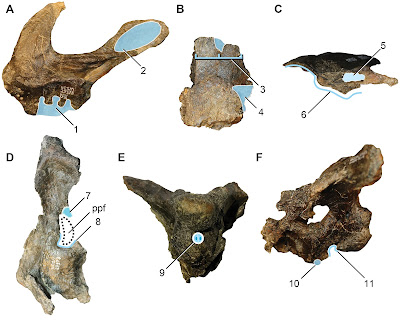 |
| Iani smithi Zanno, Gates, Avrahami, Tucker & Makovicky, 2023 |
Abstract
Intensifying macrovertebrate reconnaissance together with refined age-dating of mid-Cretaceous assemblages in recent decades is producing a more nuanced understanding of the impact of the Cretaceous Thermal Maximum on terrestrial ecosystems. Here we report discovery of a new early-diverging ornithopod, Iani smithi gen. et sp. nov., from the Cenomanian-age lower Mussentuchit Member, Cedar Mountain Formation of Utah, USA. The single known specimen of this species (NCSM 29373) includes a well-preserved, disarticulated skull, partial axial column, and portions of the appendicular skeleton. Apomorphic traits are concentrated on the frontal, squamosal, braincase, and premaxilla, including the presence of three premaxillary teeth. Phylogenetic analyses using parsimony and Bayesian inference posit Iani as a North American rhabdodontomorph based on the presence of enlarged, spatulate teeth bearing up to 12 secondary ridges, maxillary teeth lacking a primary ridge, a laterally depressed maxillary process of the jugal, and a posttemporal foramen restricted to the squamosal, among other features. Prior to this discovery, neornithischian paleobiodiversity in the Mussentuchit Member was based primarily on isolated teeth, with only the hadrosauroid Eolambia caroljonesa named from macrovertebrate remains. Documentation of a possible rhabdodontomorph in this assemblage, along with published reports of an as-of-yet undescribed thescelosaurid, and fragmentary remains of ankylosaurians and ceratopsians confirms a minimum of five, cohabiting neornithischian clades in earliest Late Cretaceous terrestrial ecosystems of North America. Due to poor preservation and exploration of Turonian–Santonian assemblages, the timing of rhabdodontomorph extirpation in the Western Interior Basin is, as of yet, unclear. However, Iani documents survival of all three major clades of Early Cretaceous neornithischians (Thescelosauridae, Rhabdodontomorpha, and Ankylopollexia) into the dawn of the Late Cretaceous of North America.
Systematic palaeontology
Dinosauria Owen, 1842
Ornithischia Seeley, 1888
Ornithopoda Marsh, 1881
Iguanodontia Baur, 1891
Rhabdodontomorpha [Dieudonné, et al., 2016]
Heterodefinitional junior synonym. Rhabdodontoidea [Poole, 2022]
Remarks: Madzia et al., [2021] provided a stem-based definition of Rhabdodontomorpha, converting the node-based definition provided by Dieudonné et al., [2016]. Under the phylogenetic topologies recovered here (and most recent published topologies e.g., [34, 36, 37, 39, 61], the definition provided by Poole [2022] for Rhabdodontoidea—a stem-based taxon including all taxa more closely related to Zalmoxes robustus and Rhabdodon priscus than to Dryosaurus altus—is a heterodefinitional junior synonym of the clade Rhabdodontomorpha defined by Madzia et al., [2021]—the maximum clade containing Rhabdodon priscus (Matheron [1869]), but not Hypsilophodon foxii (Huxley [1869]) and Iguanodon bernissartensis (Boulenger [1881]).
Iani n. gen.
Etymology: Iani (Latin)(/YAN-ee/), of Ianus, as stemming from the Roman god who presides over transitions and in reference to the changing biota of the mid-Cretaceous of western North America.
Iani smithi sp. nov.
Holotype: NCSM 29373, a partial skeleton of a skeletally immature individual.
Etymology: The species nomen honors Joshua Aaron Smith for his contributions to the discovery and conservation of paleontological resources in the region, particularly early explorations by the NCMNS.
Locality and horizon: NCSM 29373 was recovered from the lower Mussentuchit Member, upper Cedar Mountain Formation, Emery County, Utah, USA (“Fortunate Son” NCPALEOUT14; Fig 1) approximately 1.0 m above the contact with the underlying Ruby Ranch Member and ±7.0 m below MAZ1 (99.490 +0.057/-0.050 Ma) [59]. A Bayesian depositional age estimation and age-depth modelling yielded an estimated age for emplacement for NCSM 29373 that is no later than 99.652 +0.413/-0.094 Ma [59: Figs 3 and 4]. Skeletal elements of a single individual were found disarticulated and scattered across an area of approximately four-square meters. Iani was the only taxon represented in the quarry.
Diagnosis: Skeletally immature non-dryomorphan ornithopod differentiated by the following combination of characters (autapomorphies denoted with asterisk): three premaxillary teeth* (Fig 2A1); distinct oval fossa on the caudomedial aspect of premaxillary lateral process* (Fig 2A2); caudalmost margin of prefrontal facet on frontal tapering and centered between interfrontal suture and orbital rim (shared with Convolosaurus) (Fig 2B3); hatchet shaped postorbital facet on frontal with rostrally convex caudal and straight rostral margins* (Fig 2B4); posttemporal foramen housed entirely in squamosal (shared with Zalmoxes) (Fig 2C5); robust tab extending from the caudal aspect of the squamosal into concavity on the paroccipital process near its base (shared with Te. tilletti)(Fig 2C6); distinct, triangular caudomedial prong projecting off the caudal aspect of the palatine that, along with the maxilla, forms part of the lateral margin of the postpalatine foramen* (Fig 2D7); distinct u-shaped notch in ectopterygoid between the palatine and jugal process forming part of the caudal, medial, and lateral margins of the postpalatine (suborbital) foramen* (Fig 2D8); basioccipital with sharp midline lamina bordered contralaterally by two basioccipital foramina housed entirely within a depressed fossa on the rostroventral surface* (Fig 2E9); caudally projecting conical tubercle on midline of rostroventralmost tip of basioccipital* (Fig 2F10); angular occipital condyle on basioccipital with flattened ventral and caudal aspects, and a sharp, rostrally projecting lip, which together with the caudally projecting tubercle on the rostral basioccipital forms a nearly enclosed, fish-hook shaped profile of the caudoventral perimeter in lateral view* (Fig 2F11).
Lindsay E. Zanno, Terry A. Gates, Haviv M. Avrahami, Ryan T. Tucker and Peter J. Makovicky. 2023. An early-diverging Iguanodontian (Dinosauria: Rhabdodontomorpha) from the Late Cretaceous of North America. PLoS ONE. 18(6): e0286042. DOI: 10.1371/journal.pone.0286042





